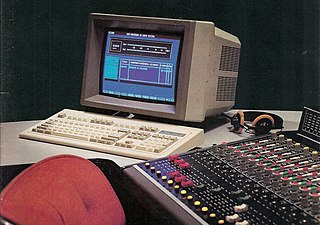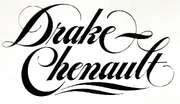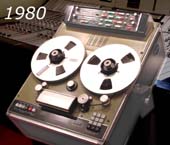
Dual-tone multi-frequency signaling (DTMF) is a telecommunication signaling system using the voice-frequency band over telephone lines between telephone equipment and other communications devices and switching centers. DTMF was first developed in the Bell System in the United States, and became known under the trademark Touch-Tone for use in push-button telephones supplied to telephone customers, starting in 1963. DTMF is standardized as ITU-T Recommendation Q.23. It is also known in the UK as MF4.

Ampex Data Systems Corporation is an American electronics company founded in 1944 by Alexander M. Poniatoff as a spin-off of Dalmo-Victor. The name AMPEX is a portmanteau, created by its founder, which stands for Alexander M. Poniatoff Excellence. Ampex operates as Ampex Data Systems Corporation, a subsidiary of Delta Information Systems, and consists of two business units. The Silicon Valley unit, known internally as Ampex Data Systems (ADS), manufactures digital data storage systems capable of functioning in harsh environments. The Colorado Springs, Colorado, unit, referred to as Ampex Intelligent Systems (AIS), serves as a laboratory and hub for the company's line of industrial control systems, cyber security products and services and its artificial intelligence/machine learning technology.
A subcarrier is a sideband of a radio frequency carrier wave, which is modulated to send additional information. Examples include the provision of colour in a black and white television system or the provision of stereo in a monophonic radio broadcast. There is no physical difference between a carrier and a subcarrier; the "sub" implies that it has been derived from a carrier, which has been amplitude modulated by a steady signal and has a constant frequency relation to it.
Voice-tracking, also called cyber jocking and referred to sometimes colloquially as a robojock, is a technique employed by some radio stations in radio broadcasting to produce the illusion of a live disc jockey or announcer sitting in the radio studios of the station when one is not actually present. It is one of the notable effects of radio homogenization.

CFMI-FM is a Canadian radio station in the Metro Vancouver region of British Columbia. It broadcasts at 101.1 MHz on the FM band with an effective radiated power of 100,000 watts (peak) from a transmitter on Mount Seymour in the District of North Vancouver. Owned by Corus Entertainment, the studios are located in Downtown Vancouver, in the TD Tower. The station has a classic hits format.
Transtar was the first radio network to provide 24-hour music programming to local affiliates. The slate of 24-hour networks is now owned by Westwood One and operated by Dial Global. The studios are located in Valencia, California.
In broadcasting, channel playout is the generation of the source signal of a radio or television channel produced by a broadcaster, coupled with the transmission of this signal for primary distribution or direct-to-audience distribution via any network. Such radio or television distribution networks include terrestrial broadcasting, cable networks, satellites, IPTV, OTT Video, point-to-point transport over managed networks or the public Internet, etc.

The Fidelipac, commonly known as a "NAB cartridge" or simply "cart", is a magnetic tape sound recording format, used for radio broadcasting for playback of material over the air such as radio commercials, jingles, station identifications, and music, and for indoor background music. Fidelipac is the official name of this industry standard audio tape cartridge. It was developed in 1954 by inventor George Eash, and commercially introduced in 1959 by Collins Radio Co. at the 1959 NAB Convention. The cartridge was often used at radio stations until the late 1990s, when such formats as MiniDisc and computerized broadcast automation predominated.
A subaudible tone is a tone that is used to trigger an automated event at a radio station. A subaudible tone is audible; however, it is usually at a low level that is not noticeable to the average listener at normal volumes. It is a form of in-band signaling.
Almost all radio stations today use some form of broadcast automation. Although some only use small scripts in audio players, a more robust solution is using a full radio automation suite. There are many commercial and free radio automation packages available.

Audicom was the first system in the world to record and play audio from a PC computer, beginning in 1988 the era of digital recording that would eliminate recorders from magnetic and cassette tape used for half a century.
The first Schafer Automation System, installed at KGEE(AM) in Bakersfield, California in 1956, was dubbed the "blue-wire job" because all of the wiring in it was blue, its inventor, Paul Schafer said. "The owner wanted to program his station all night long without a person being there. I used a couple of Seeburg record player changers to play 45s and several Ampex reel decks for commercials and we were in business," Schafer said.

Drake-Chenault Enterprises was a radio syndication company that specialized in automation on FM radio stations. The company was founded in the late-1960s by radio programmer and deejay Bill Drake (1937–2008), and his business partner, Lester Eugene Chenault (1919–2010). Drake-Chenault was the predecessor of Jones Radio Networks with its syndicated satellite-delivered formats.
In broadcasting, local insertion is the act or capability of a broadcast television station, radio station or cable system to insert or replace part of a network feed with content unique to the local station or system. Most often this is a station identification, but is also commonly used for television or radio advertisements, or a weather or traffic report. A digital on-screen graphic, commonly a translucent watermark, may also be keyed (superimposed) with a television station ID over the network feed using a character generator using genlock. In cases where individual broadcast stations carry programs separate from those shown on the main network, this is known as regional variation or an opt-out.

WSJM-FM is a commercial radio station licensed to Benton Harbor, Michigan and also serving nearby St. Joseph. The station broadcasts a News/Talk/Sports radio format. It is owned by Mid-West Family Broadcasting with studios on East Napier Avenue in Southwest Benton Harbor.

KQDJ-FM is a radio station licensed to serve Valley City, North Dakota, serving the Jamestown and Valley City areas. The station is owned by Ingstad Family Media. It airs a Top 40 (CHR) music format.
A cue tone is a message consisting of audio tones, used to prompt an action.
KJAE is a radio station broadcasting a country music format. Licensed to Leesville, Louisiana, United States, the station serves Vernon Parish and surrounding areas from a studio located in Leesville, Louisiana. The station is currently owned by Pene Broadcasting Company, Inc.
In terrestrial radio and television broadcasting, centralcasting refers to the use of systems automation by which customised signals for broadcast by multiple individual stations may be created at one central facility.










